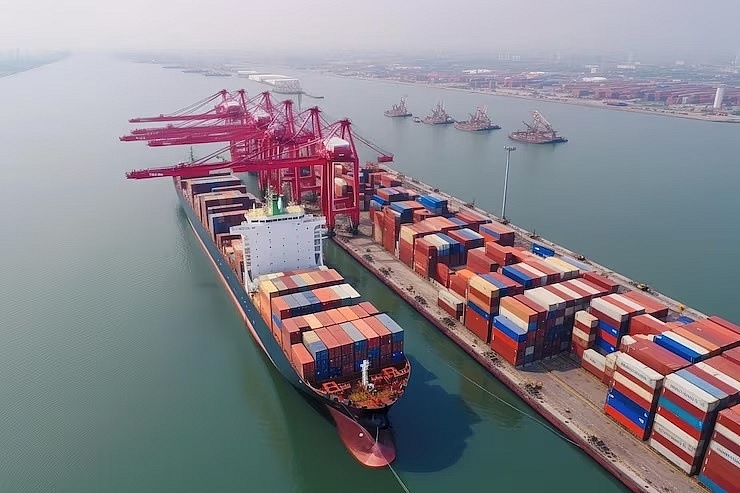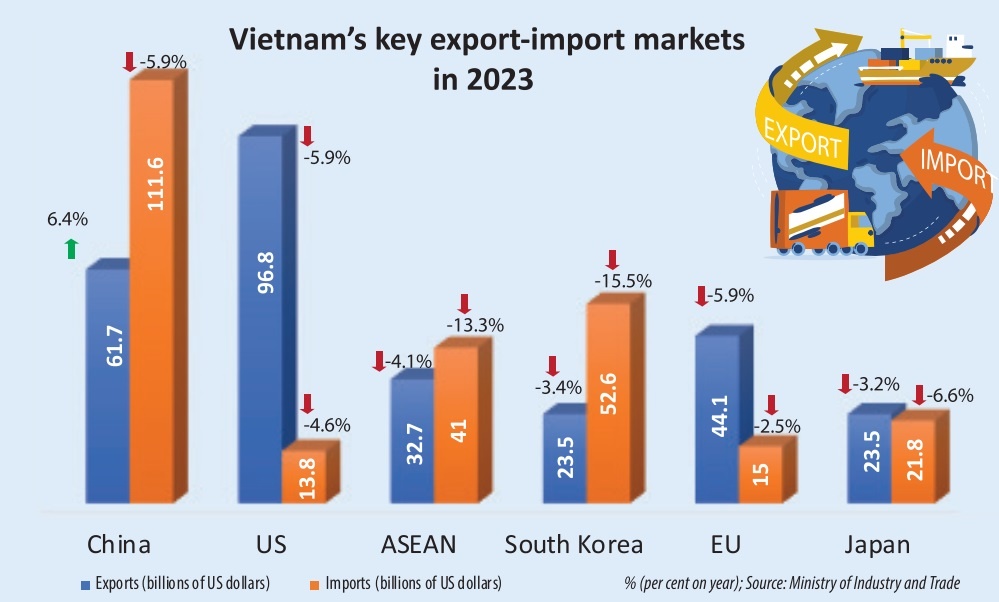Standards and remedies place pressure on exports
 |
| Standards and remedies place pressure on exports, illustration photo/ Source: freepik.com |
The government last week reported that in 2023, total export turnover of Vietnam is estimated to hit $355.5 billion, down 4.4 per cent on-year.
The global economy is gradually recovering, but still facing numerous difficulties. Many nations, including Vietnam’s major trade partners, have suffered from growth slowdown, with their demands for goods declining, affecting economies with high openness like Vietnam, according to the Ministry of Industry and Trade (MoIT).
“High inflation has imposed negative impacts and continues to be the main cause behind a continued decrease in global trade, consumption, and investment,” the MoIT said. “There has been a rise in protectionism and trade remedies, badly affecting exports of many nations.”
According to the World Trade Organization, global trade in 2023 is forecasted to have increased 1.7 per cent against 2022 when the rate climbed 2.7 per cent on-year. In recent times, the US and the EU have increased the application of technical standards on to imported goods. The standards are on green criteria, greenhouse gas emissions, and deforestation.
In 2023, Vietnam’s exports to key markets suffered from on-year drops, such as aquatic products, wood products, steel, and plastics, which “continued facing pressure about trade remedies probes and new environmental standards. This means big challenges in export markets.”
In 2023, Vietnam’s on-year export decreases could be seen in many key markets (see chart).
Vietnam’s total import turnover for 2023 is estimated to reach $327.5 billion, down 8.9 per cent, with the main cause attributed by the government to “a plummet in demands of enterprises in Vietnam for importing staples and input materials in service of export-oriented production, as domestic manufacturing performance largely depends on imported materials.”
The economy has witnessed a trade surplus of $28 billion in 2023, according to the MoIT. The government has set a target that in 2024, the total export turnover will be $380 billion and total import turnover will be $365 billion. The total trade surplus will thus be $15 billion.
The government last week required the MoIT to apply more measures to increase exports and closely control imports, and take advantage of commitments in signed free trade agreements to expand export markets.
The MoIT was also ordered to direct Vietnam’s trade offices overseas to seek more information and demands from the markets where they are located, with a view to consulting the government on how to amplify exports to these markets.
This year, the government will carry out a slew of solutions to spur investment, consumption, and exports.
“We will closely monitor and accurately forecast the world and domestic situation, as well as developments in fiscal, monetary and trade policies of major economies to have timely, appropriate, and effective policy responses,” said a government report.
However, the MoIT has warned that it will not be so easy for Vietnam to reach its export target in 2024
“There has been a rising trend in protection barriers. For example, as of November 2023, Vietnam’s exports faced 238 trade remedies probes from 24 markets. Among them, the leading examples are anti-dumping investigations with 132 cases, followed by trade remedies with 48 cases, anti-circumvention of trade remedies with 35 cases, and anti-subsidy with 23 cases,” said MoIT Deputy Minister Phan Thi Thang.
In addition to many foreign anti-dumping investigations on Vietnamese export goods, some major export markets, including the US, have also increased probes on anti-circumvention of trade remedies.
Among the investigation cases of evasion of trade remedies measures on Vietnamese export goods, there are a number of cases related to items with large export turnover, such as solar batteries and wooden cabinets.
The MoIT also underlined that Vietnam’s domestic industrial production sector is mainly export-oriented, highly dependent on the global market because domestic supply far exceeds the demand of the local market, especially for industries such as garments and textiles, footwear, and electronics. Only 10 per cent of products produced in Vietnam are consumed domestically, and the remaining 90 per cent are for export.
“Meanwhile, major economies that are Vietnam’s export partners will continue to maintain tight monetary policies, reducing expenditure on ordinary and luxury products due to difficulties in economic recovery and high levels of inventories,” said an MoIT report on Vietnam’s trade landscape last year.
 |
For example, in China, production and economic growth face risks spillover from the real estate market to the financial market. China’s Purchasing Managers’ Index continued to decrease in November 2023, reaching 49.4 points compared to 49.5 in the previous month.
In another case, although the US economy in the third quarter of 2023 grew 5.2 per cent, the recovery is not sustainable, posing potential risks to global financial and monetary markets in the last month of 2023 and in 2024. In November 2023, Moody’s lowered the US credit outlook from “stable” to “negative.” Meanwhile, the EU economy continues to show signs of recession.
 | Vietnam’s exports to hit almost $535 billion by 2030 "Future of Trade 2030: Trends and markets to watch" – a new research by Standard Chartered – projects that global exports will almost double from $17.4 trillion to $29.7 trillion over the next decade. The report reveals 13 markets that will drive much of this growth, identifies major corridors, and five trends shaping the future of global trade. Vietnam is a key driver of this global trade growth, with its exports projected to grow at an average annual rate of more 7 per cent to cross $535 billion by 2030. |
What the stars mean:
★ Poor ★ ★ Promising ★★★ Good ★★★★ Very good ★★★★★ Exceptional
 Tag:
Tag:
Related Contents
Latest News
More News
- Businesses ramp up production as year-end orders surge (December 30, 2025 | 10:05)
- Vietjet chairwoman awarded Labour Hero title (December 29, 2025 | 13:06)
- How to unlock ESG value through green innovation (December 29, 2025 | 10:03)
- AI reshapes media and advertising industry (December 29, 2025 | 08:33)
- FPT and GELEX sign deal to develop blockchain tech for global markets (December 29, 2025 | 08:29)
- Vietnam’s GDP forecast to grow by 9 per cent in 2026 (December 29, 2025 | 08:29)
- Women entrepreneurs are key to Vietnam’s economic growth (December 29, 2025 | 08:00)
- Vietnam's top 500 value-creating enterprises announced (December 27, 2025 | 08:00)
- The PAN Group shaping a better future with ESG strategy (December 26, 2025 | 09:00)
- Masan Consumer officially lists on HSX, marking the next phase of value creation (December 25, 2025 | 13:20)























 Mobile Version
Mobile Version